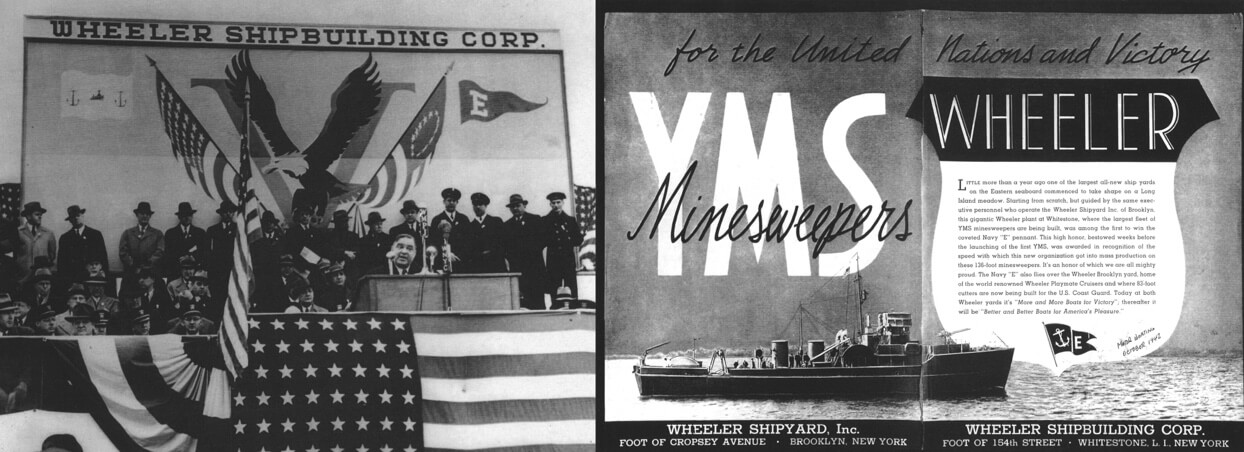
On June 6, 1944, American, British, Canadian and Australian soldiers arrived at one of the most hellish battle scenes in modern warfare. Operation Overlord had brought their ships to the beaches of Normandy, France, where they were greeted with heavy shelling raining down from the cliffs above. Carnage and chaos were everywhere as the world’s largest amphibious invasion began.
It was D-Day, and after 24 harrowing hours, more than 5,000 Allied troops were wounded and 4,414 had made the ultimate sacrifice. While the death toll was steep, more than a thousand men lived to see another day, many of whom were rescued by Wheeler-built ships.
Wheeler Supports America’s War Effort
What started as Germany’s invasion of Poland in 1939 eventually snowballed into a global conflict. On December 7, 1941, Japanese forces attacked the United States Naval Station Pearl Harbor, killing 2,403. Our country’s previously isolationist stance was abandoned and the government declared war on Japan the next day.
Leading up to WWII, the Wheeler family had solidified its reputation as the designers and carpenters of fine luxury yachts. But what they did next made history. Starting in 1940, the Wheelers paused construction of their pleasure craft for a valiant cause: military shipbuilding. Over the next five years, they built more than 400 vessels for the U.S. Coast Guard, Army and Navy.
With the changing colors of the autumn leaves came Wheeler’s first military order: a fleet of 26-foot army mine yawls. Next came a request for 60-foot bomb target boats and then a $1.9 million order from the U.S. Coast Guard, requesting 40 83-foot patrol boats. Each order was placed at the original Wheeler Shipyard Corporation, located in Brooklyn, New York.

The patrol boats were made entirely of wood and designed by a 40-year-old Wesley L. Wheeler and outside design agent Walter McInnis. Equipped with twin sterling gasoline engines of 600 HP each, the boats could cruise at 12 knots. After the craft’s success, Wheeler would go on to build 230 of these ships over the course of the war.
In his 1942 “On the Home Front” speech, former President Franklin D. Roosevelt declared, “So having seen the quality of the work and of the workers on our production lines — and coupling these firsthand observations with the reports of actual performance of our weapons on the fighting fronts — I can say to you that we are getting ahead of our enemies in the battle of production.”
Sailing ahead in the production boom were victory ships, and they became more significant than the Wheelers ever imagined.
Pulled from Death’s Grip
Today it is a beach, but on June 6, 1944, it was a battlefield as Allied troops stormed the shore. D-Day proved a major turning point in the defeat of Hilter’s Europe, planned for months by General Eisenhower, alongside British, Canadian and Australian leaders.
Several thousand ships were needed for the invasion, leading Roosevelt to initiate the Lend-Lease Act. This program allowed the U.S. government to send ships and landing craft to England for the invasion. Wheeler’s Coast Guard patrol boats, also called “cutters,” were amongst the vessels sent across the sea. With 12 of the 60 boats already on loan to the Cuban Navy, 48 Wheeler vessels participated in D-Day.
To attack the beach rife with German soldiers, Allied troops had to charge in waves. The first wave experienced the most casualties, but one soldier lived to 101 years old and told his story in a memoir. Co-authored with Jim DeFelice, Ray Lambert called it “Every Man a Hero: A Memoir of D-Day, the First Wave at Omaha Beach, and a World at War.”
“Where tourists and vacationers see pleasant waves, I see the faces of drowning men,” Lambert wrote. “Amid the sounds of children playing, I hear the cries of men pierced by Nazi bullets.”
In the water, the scene was just as horrific as the action unfolding on the beach. Over the course of the day, thousands of men were exposed to the English Channel’s bone-chilling 54 F water and struggled to swim under the unrelenting weight of their gear.
Some were accidentally dropped off too early, others were airplane pilots who were shot out of the sky or aboard ships that had been sunk. But as many thrashed in the water, a glimmer of hope sailed toward them.
The calvary on this historic day included Wheeler ships who were members of the Rescue Flotilla One, nicknamed the “Matchbox Fleet” because the vessels were made of wood. Their job was to patrol the English Sound for pilots or infantrymen, rescue them from the water and return those lucky souls to base.
On the first day of the invasion, the Matchbox Fleet rescued 194 pilots off Omaha Beach, 157 off Utah Beach, and 133 off Juno, Gold and Sword beaches. Over the course of the invasion, 1,438 lives were saved by these rescuers, Wheeler craft among them. The cutters did their duty.
Remembering the Wheeler Sacrifice
To thank them for their service, the Wheelers received their first Navy “E” Pennant for their work with the U.S. Coast Guard in April 1942. Among those present for the award ceremony was Mayor Fiorello La Guardia at their Whitestone plant, honoring their sacrifice and bravery.
To learn more about the legacy of the Wheeler Yacht Company, read more stories on our blog.
